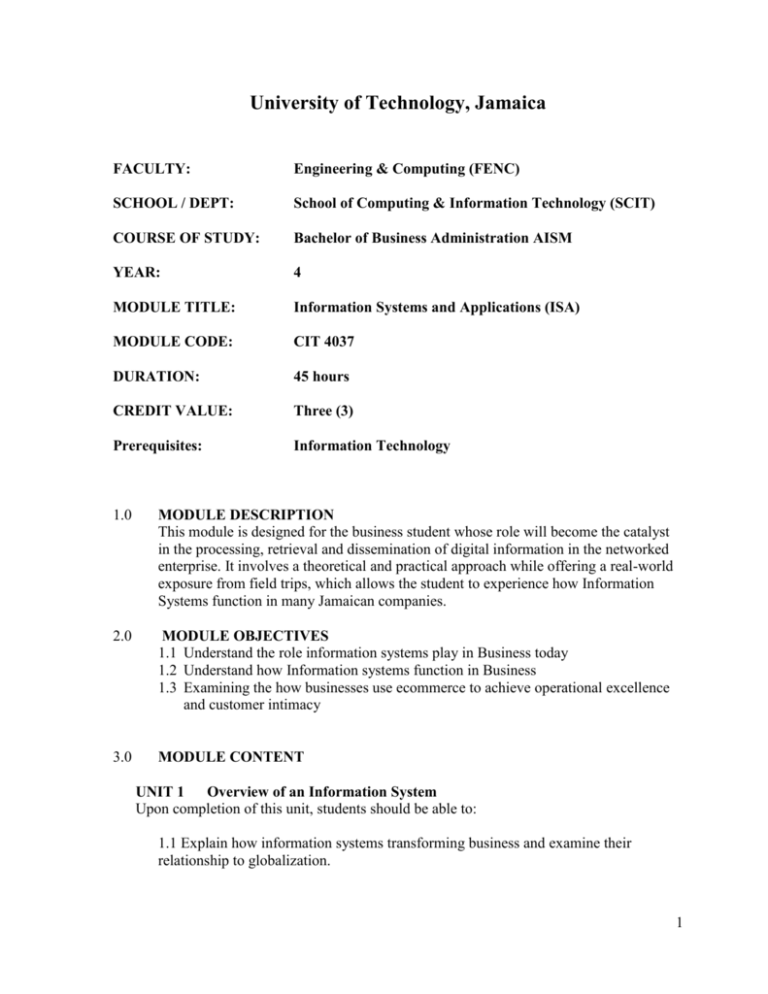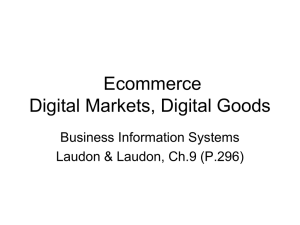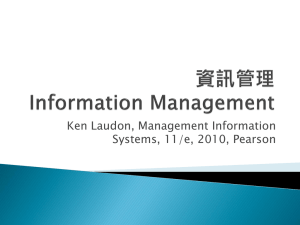Unit 2 E-Business: How Businesses Use Information
advertisement

University of Technology, Jamaica FACULTY: Engineering & Computing (FENC) SCHOOL / DEPT: School of Computing & Information Technology (SCIT) COURSE OF STUDY: Bachelor of Business Administration AISM YEAR: 4 MODULE TITLE: Information Systems and Applications (ISA) MODULE CODE: CIT 4037 DURATION: 45 hours CREDIT VALUE: Three (3) Prerequisites: Information Technology 1.0 MODULE DESCRIPTION This module is designed for the business student whose role will become the catalyst in the processing, retrieval and dissemination of digital information in the networked enterprise. It involves a theoretical and practical approach while offering a real-world exposure from field trips, which allows the student to experience how Information Systems function in many Jamaican companies. 2.0 MODULE OBJECTIVES 1.1 Understand the role information systems play in Business today 1.2 Understand how Information systems function in Business 1.3 Examining the how businesses use ecommerce to achieve operational excellence and customer intimacy 3.0 MODULE CONTENT UNIT 1 Overview of an Information System Upon completion of this unit, students should be able to: 1.1 Explain how information systems transforming business and examine their relationship to globalization. 1 1.2 Describe how information systems are so essential for running and managing a business today. 1.3 Describe an information system. Explain how it works 1.4 Define what are management, organization, and technology components 1.5 Explain what complementary assets are. State the complementary assets essential for ensuring that information systems provide genuine value for an organization 1.6 Describe academic disciplines are used to study information systems. 1.7 Explain how each contribute to an understanding of information systems. 1.8 Examine the socio-technical systems perspective. Content The Role of Information Systems in Business Today How Information Systems are Transforming Business What’s New in Management Information Systems? The Emerging Digital Firm Strategic Business Objectives of Information Systems Perspectives on Information Systems What is an Information System? Dimensions of Information Systems It Isn’t Just Technology: A Business Perspective on Information Systems Contemporary Approaches to Information Systems Technical Approach Behavioral Approach Unit 2 E-Business: How Businesses Use Information Systems Upon completion of this unit, students should be able to: 2.1 Explain business processes. How are they related to information systems? 2.2 Define how systems serve the various levels of management in a business 2.3 Describe how enterprise applications, collaboration and communication systems, and intranets improve organizational performance 2.4 Evaluate the difference between e-business, e-commerce, and e-government 2.5 Define the role of the information systems function in a business Contents Business Processes and Information Systems Business Processes How Information Technology Enhances Business Processes Types of Information Systems Systems That Span the Enterprise 2 Collaboration and Communication Systems: “Interaction” Jobs in a Global Economy E-Business, E-Commerce, and E-Government The Information Systems Function in Business Unit 3 Strategic Information Systems Upon completion of this unit, students should be able to: 3.1 Assess the features of organizations managers need to know about building and using information systems successfully. 3.2 Determine the impact of information systems on organizations. 3.3 Assess how Porter’s competitive forces model help companies develop competitive strategies using information systems. 3.4 How do the value chain and value web models help businesses identify opportunities for strategic information system applications. 3.5 How do information systems help businesses use synergies, core competencies, and network-based strategies to achieve competitive advantage? 3.6 What are the challenges posed by strategic information systems and how should they be addressed? Contents Organizations and Information Systems How Information Systems Impact Organizations and Business Firms Using Information Systems to Achieve Competitive Advantage Using Systems For Competitive Advantage: Management Issues Unit 4 E-commerce: Upon completion of this unit, students should be able to: 4.1 Assess the unique features of e-commerce, digital markets, and digital goods. 4.2 Examine how Internet technology changed business models. 4.3 Compare the various types of e-commerce and examine how e-commerce changed consumer retailing and business-to-business transactions. 4.4 Examine the role of m-commerce in business and the most important m-commerce applications. 4.5 Describe the principal payment systems for electronic commerce. Contents 3 E-Commerce Today Why E-commerce Is Different Key Concepts in E-commerce: Digital Markets and Digital Goods in a Global Marketplace Internet Business Models Types of Electronic Commerce Achieving Customer Intimacy: Interactive Marketing, Personalization, and Self-Service Business-to-Business Electronic Commerce: New Efficiencies and Relationships M-Commerce Services and Applications Accessing Information from the Wireless Web Types of Electronic Payment Systems Digital Payment Systems for M-Commerce 4.1 Examine several advantages of e-commerce. 4.2 Outline a model that describes how e-commerce works. 4.3 Assess some of the major challenges that companies must overcome to succeed in e-commerce. 4.4 Describe some of the current uses and potential benefits of m- commerce. 4.5 Compare several e-commerce applications. Contents Introduction to electronic Commerce Mobile commerce E-Commerce applications Technology infrastructure Electronic Payments systems Threats to E-Commerce Strategies for successful E-Commerce. Unit 5 – Telecommunication, the Internet and Wireless Technology Upon completion of this unit students should be able to: 5.1 Examine the principal components of telecommunications networks and key networking technologies. 5.2 Discuss the main telecommunications transmission media and types of networks 5.3 Examine how the Internet and Internet technology work, and how do they support communication and e-business. 5.4 Compare the principal technologies and standards for wireless networking, communication, and Internet access. 4 5.5 Examine the use radio frequency identification (RFID) and wireless sensor networks for business. Contents o o o o o o o o o o o o o o Networking and Communication Trends Computer Network Communications Networks Signals: Digital vs. Analog Types of Networks Physical Transmission Media The Internet Internet Addressing and Architecture Internet Services and Communication Tools The World Wide Web Intranets and Extranets The Wireless Revolution Cellular Systems Wireless Computer Networks and Internet Access o RFID and Wireless Sensor Networks Unit 6 - Data Management and Data Mining Upon completion of this unit students should be able to: 6.1 Assess the problems of managing data resources in a traditional file environment 6.2 Demonstrate the problems solved by a database management system. 6.3 Examine the major capabilities of database management systems (DBMS) and demonstrate why a relational DBMS is powerful. 6.4 Analyze the important principles of database design. 6.5 Examine the principal tools and technologies for accessing information from databases to improve business performance and decision-making. 6.6 Examine the information policy, data administration, and data quality assurance essential for managing the firm’s data resources. Contents Organizing Data in a Traditional File Environment The Database Approach to Data Management Using Databases to Improve Business Performance and Decision Making Data Warehouses Business Intelligence, Multidimensional Data Analysis, and Data Mining Databases and the Web Managing Data Resources Establishing an Information Policy Ensuring Data Quality 5 Unit 7 Information Infrastructure and Architecture Upon completion of this unit students should be able to: 7.1 Define IT infrastructure and its components 7.2 Explain the stages and technology drivers of IT infrastructure evolution 7.3 Evaluate the current trends in computer hardware platforms 7.4 Describe the current trends in software platforms 7.5 Assess the challenges of managing IT infrastructure and management solutions Contents IT Infrastructure Infrastructure Components Contemporary Hardware Platform Trends Processing Contemporary Software Platform Trends Management Issues Unit 8 Enterprise Applications Upon completion of this unit students should be able to: 8.1 Demonstrate how enterprise systems achieve operational excellence. 8.2 Examine how supply chain management systems coordinate planning, production, and logistics with suppliers. 8.3 Demonstrate how customer relationship management systems achieve customer intimacy. 8.4 Assess the challenges and new opportunities raised by enterprise applications. 8.5 Determine how enterprise applications are used for cross-functional services. Contents Enterprise Systems Enterprise Software Business Value of Enterprise Systems Supply Chain Management Systems Customer Relationship Management Systems Business Value of Customer Relationship Management Systems Enterprise Applications: New Opportunities and Challenges Enterprise Application Challenges Extending Enterprise Software 6 Unit 9 - Emerging Technologies in IS Applications Upon completion of this unit students should be able to: 9.1 Examine current technologies and research the new technologies 9.2 Compare and contrast new trends in IS. Contents Research on new technologies and trends 4.0 LEARNING AND TEACHING APPROACHES Lecture sessions that will introduce the theoretical basis for the applications. Group presentations Hands on instructions in a real world (simulated environment) Lab sessions to explore applications Field trips to enhance appreciation of the relationship between information systems and industries. 5.0 BREAKDOWN OF HOURS Lecture 30 hours Tutorials 15 hours 6.0 TEXTBOOKS AND REFERENCES Required text : Management Information Systems Laudon and Laudon 11th Edition 7.0 SYLLABUS WRITER/DEVELOPER Caroline Parkes 8.0 DATE OF REVISION May 2009 7








